I wrote in the last installment of Wildlife Wednesday that the bulk of migrating birds seemed to have skipped right over my garden. Well, I was wrong–they’ve arrived for rest, water and insects throughout April and it’s been a parade of colorful feathers most days. Today is the first Wednesday of the month, the day wildlife gardeners celebrate those who require our gardens for their survival.
Gardening for wildlife is fun and an important step toward mitigating the damage to the natural environment caused by urbanization and industrialization. Attracting wildlife to the garden is a simple process, if a few basic principles are followed: providing water, cover (in the form of shrubs and trees), shelter for young, and practicing sustainable gardening methods, including utilizing native plants, limiting or eliminating chemicals, and pruning well after migration in spring and fall, leaving nutritious seeds for mammals and birds, and protection for young. Check out the National Wildlife Federation for more information on the how-tos of wildlife gardening and start your own wildlife friendly garden–you won’t regret it.
Besides the migrants, there was plenty of other “stuff” in the garden, like this little spider, lying in wait to catch-n-munch a bee or fly that might have the misfortune of landing on this Zexmenia bloom, Wedelia acapulcensis var. hispida.
That spider would have snatched a meal if it had instead been loitering on this Zexmenia bloom, complete with native bee ready for the eating.
There are plenty of other native bees, as well as honeybees and butterflies in the garden now, and lots in bloom for them to eat, but this syrphid fly was a pleasure to photograph as it rested after nectaring at a non-native poppy and some native Shrubby blue sage, Salvia ballotiflora.
Pollinators and the predators are great, but in my garden this past month, the migrating birds took center stage so, let’s talk birds, shall we? Aside from the year-round resident avians, Texas lies along a major north-south migration route. During spring and autumn migration, birders flock (yuk-yuk!) to Texas to catch glimpses and glean photos of the many birds of the Americas as they make their way through Texas. Though the Gulf of Mexico coastline outshines the birding here, Central Texas has some birding game to brag about.
At the beginning of April, I was still enjoying visits from the Yellow-Rumped warblers, Setophaga coronata,
…and the Orange-crowned Warblers, Oreothlypis celata.
I haven’t seen either for a while and I’ll bet those cuties have headed north and their daily visits to my garden are now ended. I was glad to host these winter Texans from November into early April.
I’ve seen this handsome charmer on a number of occasions, but these were the best shots I managed:
I’m fairly sure he’s a Lincoln’s Sparrow, Melospiza lincolnii. Another visited about the same time last year and was camera shy. These birds are winter Texans, not showy, but subtle and elegant in color and form. They hop along the ground, looking for seeds, in the cutest way imaginable. I’m still seeing one or two, several times each week, but they’re headed to other parts of North America and will soon be gone from my garden.
Early one morning I squealed with delight when I walked by a window and spotted this “lifer” in the back garden, eyeing my pond:
The Black-throated Green Warbler, Setophaga virens, winters primarily in Central America, migrating through the eastern half of the US, finally arriving in Canada to breed and raise young. Canada is a nice place to grow up, I hear.
And yes, you might have noticed the term “lifer” that I slipped into above. That’s a term that real birders use when they’ve seen a bird species for the first time. I’m loathed to use that term because if I do, it means I’m a birder, and I’m trying desperately to avoid that label.
How am I doing so far??
Another new bird for me is this beautiful Blue-headed Vireo, Vireo solitarius.
Not the best of photos because it was taken at a distance and from inside my house (sometimes that method of photo-taking works, sometimes it doesn’t), this bird’s colors and markings are striking. He’s quick and skittish and has visited a number of times, or perhaps, it’s been visits from several. The vireo and the Black-throated Green share an almost identical wintering, migrating, and breeding geographic pattern.
The bee hunters are back and gobbling up my honeybees and probably, some native bees as well. I first noticed this attractive female Summer Tanager, Piranga rubra, in the tree under which my honeybee hives, Buzz and Woody, reside.
I love to watch these birds hunt.
Like most predators, they’re smart: note her bright eyes as she searches for her next buzzy snack.
Tanagers catch bees (and wasps and other flying insects) on the wing, take their prey to a tree, bash (ooh!) the hapless critters on a branch, remove the stingers and gulp their meal. These beauties breed in Texas, as well as much of the southern part of the US, though I’ve only seen them in April and May, and coincidentally, since I started beekeeping.
Ahem.
I next caught a quick look-see and shot of a juvenile male, though he didn’t stick around long.
And just this past weekend, an eye-popping adult male graced my garden.
So gorgeous! He swooped and then rested, then swooped again.
I hope a few Summer Tanagers will hang around for the duration of the season; I’d be willing to sacrifice a few of my honeybees for their company.
Last week, a (probably) weary migrating female Painted Bunting, Passerina ciris, bathed briefly in my water-pump infused birdbath.
So pretty, but I still hope to see a startlingly beautiful male before the Buntings head just a little north of here to raise their families. Last year, a pair hung out in my garden for about a week, which you can see here, noshing on the seeds of the early spring blooming Gulf Coast Penstemon, Penstemon tenuis. Using native plants in your garden is a good way to attract migrating songbirds, as well as to feed the native birds of your region.
This blast of sunshine, a Yellow Warbler, Setophaga petechia, flashed through my garden this past Sunday–I’m so glad I was home to see him!
As a bonus, he stopped and posed for me at the base of the pond.
Playing at being coy, I think!
He’s a gorgeous hunk of avian masculinity and I’m sure he’ll have no trouble finding a mate. Though I suppose all of the male Yellow Warblers are just as pretty, so maybe the competition is tough? He and his partner(s) will breed far north of here and if I’m lucky, maybe another will stop and chirp at me in October, as the Yellows make their way back to Central America.
Another lifer (ugh) for me is this female Baltimore Oriole, Icterus galbula, who also visited recently. Baltimore Orioles are known for the stunning good looks of the male and the birds’ affection for orange slices in the garden. I am thrilled that this lone female spent time in the birdbath.
Though perhaps outclassed by her male counterpart in the looks department, I find her coloring and markings quite lovely.
Yet another bird common to the eastern part of North America, she’s on her way north, but made a quick stop to refresh and I’m pleased my garden was a respite for her. After her drink and bath, what else would a Baltimore oriole do? Steal some yummy blackberries, of course!
Migration is happening and the birds are moving through–I imagine in the next days, it’ll be the resident birds, and maybe their charming offspring, whose feathery presence will dominate.
For those following the goings-on of the goldfish-snarfing heron,
…I found two of the four goldfish hunkering under a ledge of the bog in the pond since posting about the sushi-loving bird. The lily pads are unfurling in rapid succession and I’ve witnessed the bigger of the two goldfish swimming around, no doubt feeling more confident that hiding under the leaves is a good bet for survival. I’m certain the fish are breathing a gilled sigh of relief.
Migrating or otherwise, did wildlife visit your garden this past month? Please post for May Wildlife Wednesday. Share photos and stories of your garden wildlife to promote and appreciate your region’s natural habitat and diversity. When you comment on my post, please remember to leave a link to your Wildlife Wednesday post so readers can enjoy a variety of garden wildlife observations.
Happy wildlife gardening!
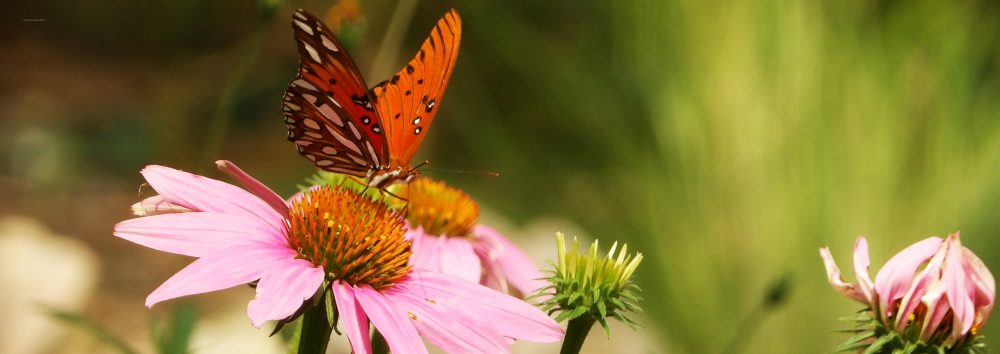
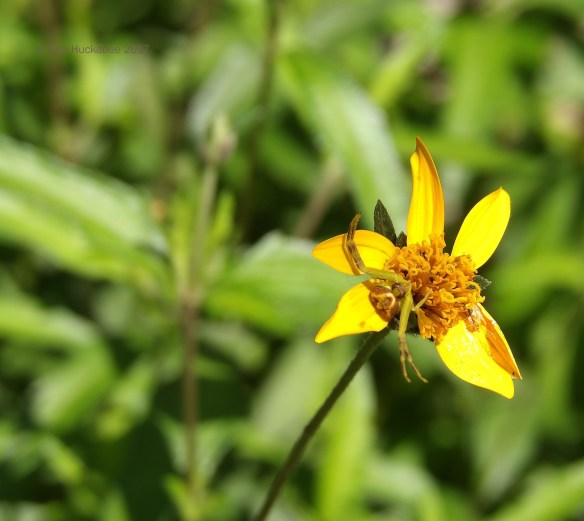
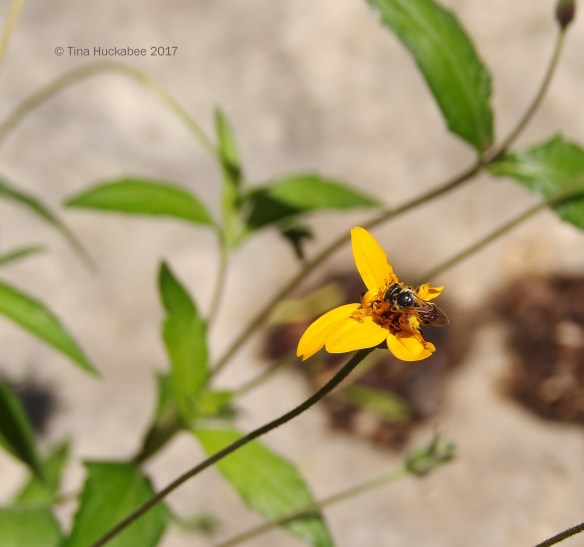
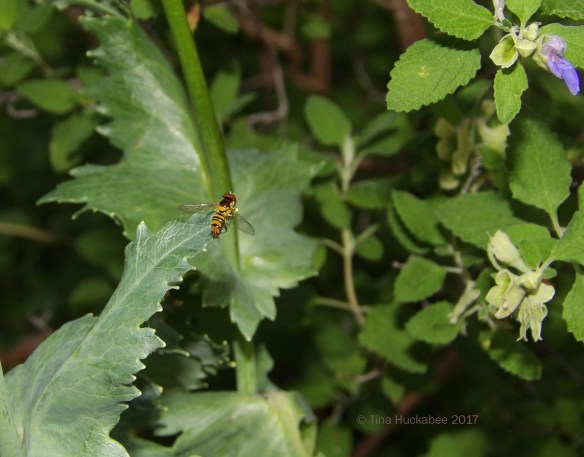
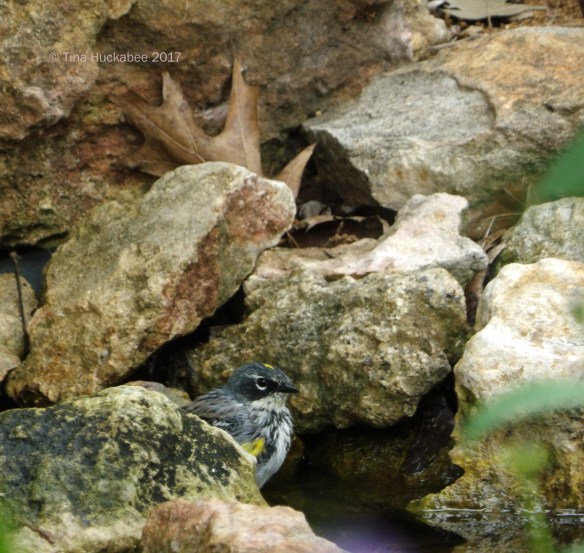
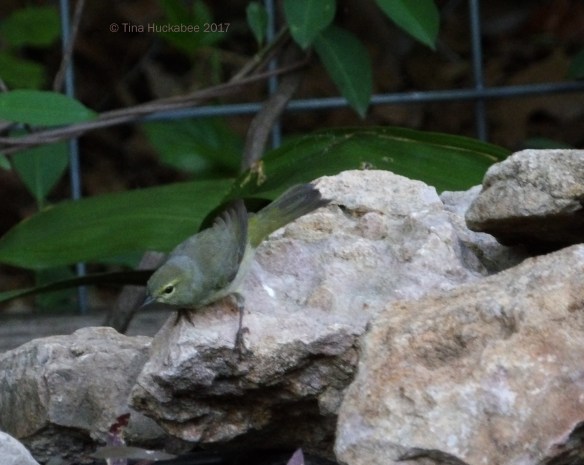

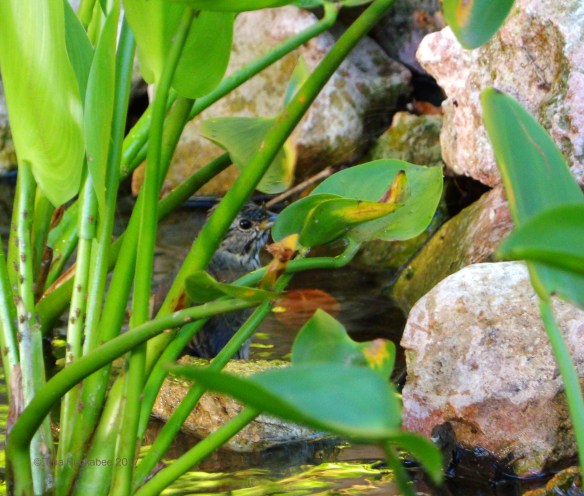
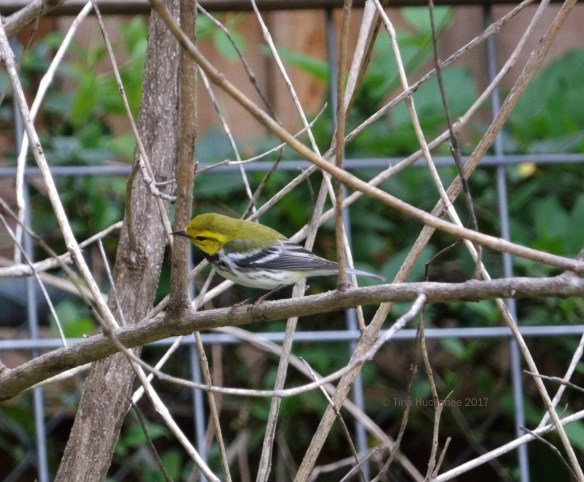
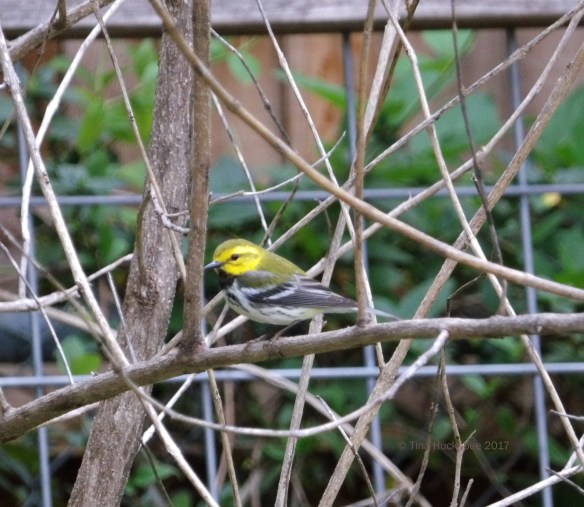
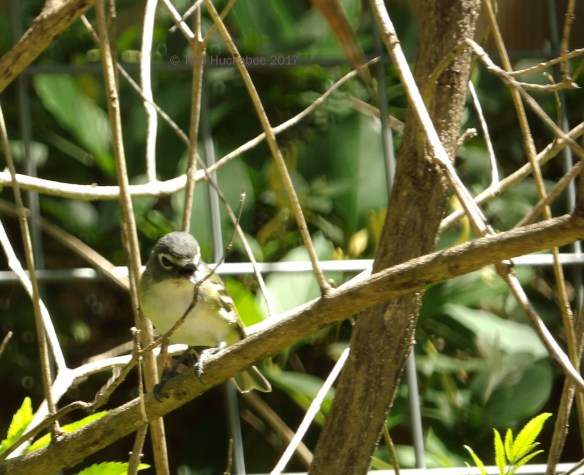

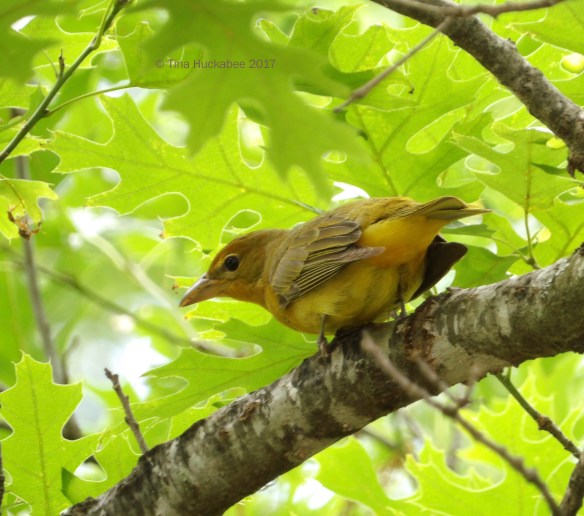

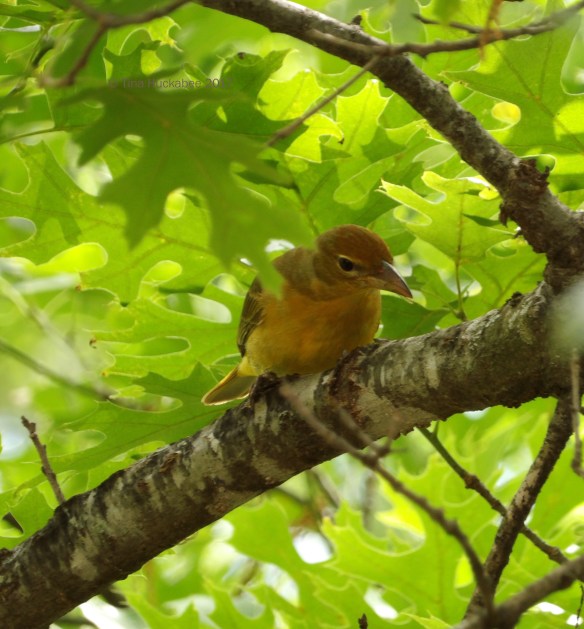
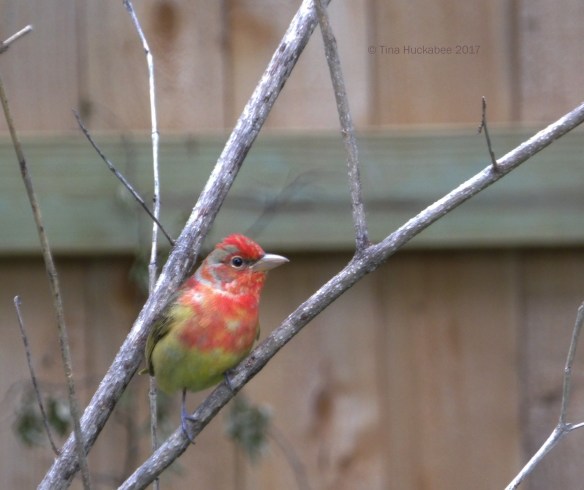
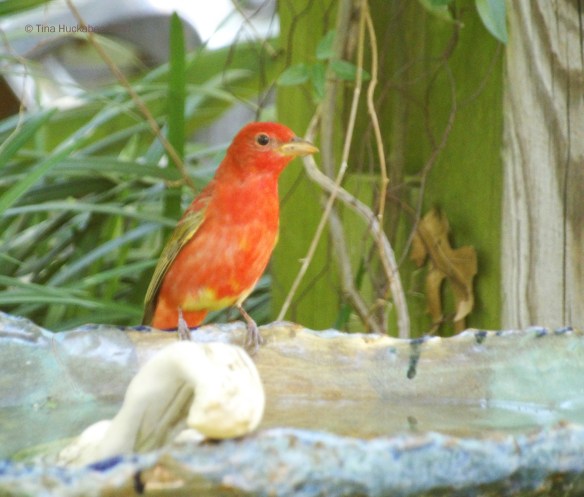
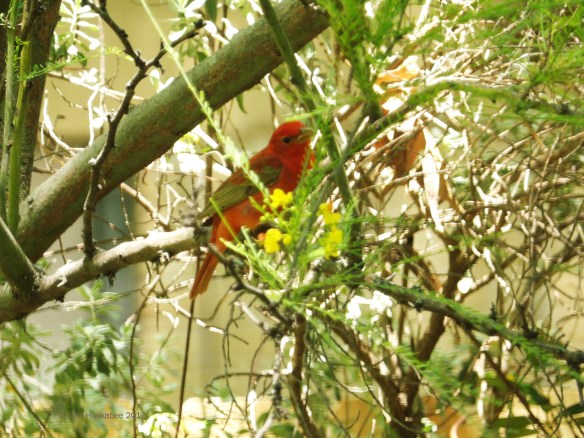
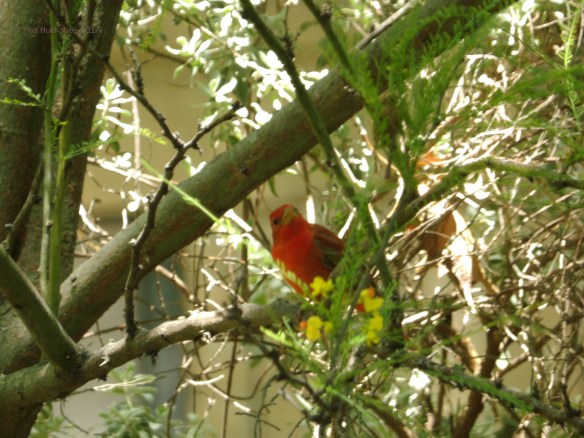







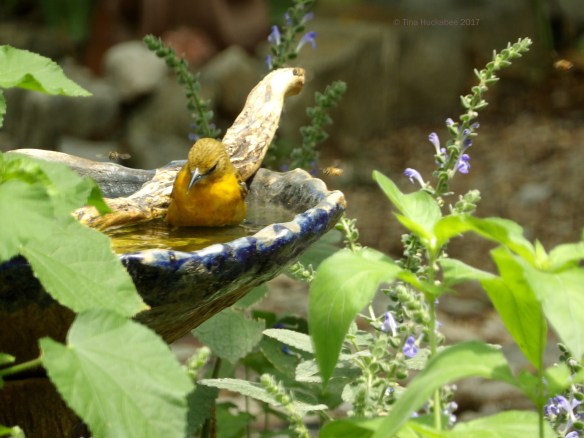





Great post and beautiful photos!
LikeLike
Thanks!!
LikeLike
Great post. I loved seeing all the birds.
LikeLike
Thanks–and me too!
LikeLike
Enjoyed seeing your bird visitors. We’ve not seen tanagers here in many years. And painted bunting–lucky you.
LikeLike
Yes, it’s a real gift to see buntings. Last spring was the first time I’d ever seen one.
LikeLike
I think your little spider might be a crab spider. I found one living in the midst of a gone-to-seed thistle recently, and he turned out to be the cutest thing ever.
You have such a variety of birds: proof positive that what you say about the ability of water, food, and shelter to draw wildlife. Even at my place, water alone draws doves, pigeons, house finches, sparrows, cardinals, bluejays, and grackles. Granted, some of those wouldn’t excite everyone, but they certainly entertain, and deserve to have their needs met, too. If I could add feed, I’d probably have even more, but at least I can put out peanuts in the shell and raisins. That makes the mockingbirds and bluejays happy!
LikeLike
Yes, that little gal was a crab spider, they’re quite common but she sat and sat, so I thought she deserved a photo. You’re right about water being the big draw–and moving water, especially. I like all the common birds–I could do with few doves, but they’re part of the garden’s fabric as well as the more exotic visitors. And your close-up of the spider–Wow!!
LikeLike
Pingback: Wildlife Wednesday – A sense of hidden things | Frogend dweller's Blog
Well done on all your first spots. What a twitcher! You’ve got some real beauties there. I love the purposeful appearance of the Tanagers and that their juveniles are all splodgy red colours. Funnily enough, my eldest son used to do his hair just like that when he was a teenager! The yellow warbler is an amazing colour too. A complete dose of sunshine in one tiny bird.
Here is my wildlife post: http://wp.me/pM8Y1-59y
LikeLike
Haha–I’ve also seen teens with similar hair…my son’s was long, but not pink or green or….
Isn’t the yellow warbler YELLOW! One can’t miss it zooming through the air!
LikeLike
You have a really nice variety of visitors. I did not know the Tanagers ate bees. Tanagers do show up here, but are mostly high in the trees.
LikeLike
Yes, the first time I saw a tanager (2-3 years ago), it was catching bees, I looked it up and sure enough!
LikeLiked by 1 person
What an wonderful ongoing parade of wild visitors and residents you have. Obviously we humans aren’t the only ones who enjoy and admire your gardening approach. Do the birds (and squirrels?) get most of your berries? I know my hub would like to try growing some but he thinks HE would get to eat them, while I’m fairly certain everybody BUT us would be eating most of them.
Your thoughts?
LikeLike
Actually the main blackberry vine survives mostly un-bird-molested. Insects sometimes may hay and holes, but it’s the back, very shaded vine where the birds snitch the berries from and I’m okay with that.
LikeLike
Tina how many beautiful visitors she has. The photos are beautiful and the post magnificent. How much to its winged visitors are all divine. I love the Yellow Warbler, the Perennial Chain, the Tanagers and the Herons that come back for their goldfish. I am learning a lot with you about how to put the garden so that wildlife comes to live in it or to visit it. Today he has given me many ideas. Thank you very much for your post. Greetings from Margarita.
LikeLike
Thanks, Margarita–I’m glad you liked the post. It was a treat to see so many different birds through the garden this month.
LikeLike
What a nice parade of birds 🙂 I’ll keep an eye for the Black-throated Green Warbler, if they decide to stop by at our place. I think the birds and all others know about what’s happening around here and stay away these days – never ending rains with gusty winds and below zero expected by Sunday!
LikeLike
I certainly hope you can stop with the cold stuff–it’s spring, you know! And, I hope you see some pretty warblers you way and soon.
LikeLike
The Warblers, the Summer Tanagers, the Painted Buntings – all fabulous! I’m very jealous of your range of birds. We get Baltimore Orioles and Red Breasted Grosbeaks, and an occasional Warbler. I find the Warblers are often elusive – hard to get a clear view of them.
LikeLike
We get quite a few, it’s just a matter of keeping an eye out and making the garden welcome for them. I agree, warblers are really tough to see and especially to photograph. I wish I had more time, but I’m also not sure I quite have the patience to sit…sit…sit… and wait…wait…wait….
LikeLike
Oh the warblers! The Tanagers! Oh my, what a beautiful range of bird visitors. I have stopped feeding the birds due to the presence of feral cats so I can enjoy birds through your post. I have spotted a few non-bird visitors this month. Mostly babies.
http://rockoakdeer.blogspot.com/2017/05/wildlife-wednesday-may-2017.html
LikeLike
Sorry about the cat business–I’m glad though that you’re not encouraging the birds, they’d be in trouble. It’s been a really good migration season this spring.
LikeLike
Great spider, pollinator, and bird photos! I’m still waiting on the Orioles and Hummingbirds, but the Chipping Sparrow and White-Throated Sparrow are here now. Last year, we had so many migrating birds come through around now–Grosbeaks, Indigo Buntings, and even a Scarlet Tanager, which is a rare sight in my garden. I’m glad your goldfish are finding ways to survive. 🙂
LikeLike
The orioles will be there soon–I’m doing my part to prep them for the journey, leaving orange (actually, tangerine slices) and it’s paid off: there were two males and a female yesterday evening! I’ve never seen a chipping or a white-throated, so that’s nice that you have them.
LikeLike
wow Tina what a parade of lovely birds, my wildlife offering is posted, thanks for hosting, Frances
LikeLike
Yes, it’s been lovely to catch sight of these beautiful migrating birds!
LikeLike
Wonderful photos, especially the tanager and oriole. The heron…not so much. Sorry about your fish.
LikeLike
Thanks! I’m not fussed about the fish. Everyone must eat and the heron is only doing what herons are supposed to do–fish for their meals.
LikeLiked by 1 person
Pingback: Wildlife Visitors in April 2017 – My Wild Australia
Wow, stunning colours of the tanagers and especially the yellow warbler. Loved the photos of the oriole in the birdbath, very cute!
LikeLike
Thanks! The migratory birds are still coming through; each day is a new crop–I wish I could spend more time watching them!
LikeLiked by 1 person
Pingback: Wildlife Wednesday: Migrants | My Gardener Says…